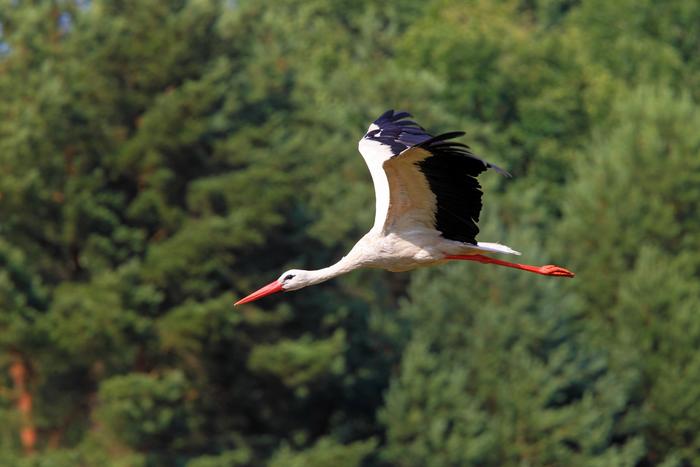With long legs and large wings, the white stork is a prominent star of the pageant that is animal migration. Flying from Europe towards Africa in autumn, and then back again in spring, birds can be seen taking to the sky in conspicuous flocks that herald the changing of the seasons. Now, a study from the Max Planck Institute of Animal Behavior in Konstanz, Germany, has an explanation for how this collective phenomenon forms: the storks are choosing to fly together. With data on lifetime migrations of 158 storks, the study provides the first evidence of the social preference of storks during migration. In a paper, the researchers show that storks chose routes that were heavily trafficked by other storks. Yet, young storks tuned their routes to social hot-spots more than adults did.

Credit: Christian Ziegler
With long legs and large wings, the white stork is a prominent star of the pageant that is animal migration. Flying from Europe towards Africa in autumn, and then back again in spring, birds can be seen taking to the sky in conspicuous flocks that herald the changing of the seasons. Now, a study from the Max Planck Institute of Animal Behavior in Konstanz, Germany, has an explanation for how this collective phenomenon forms: the storks are choosing to fly together. With data on lifetime migrations of 158 storks, the study provides the first evidence of the social preference of storks during migration. In a paper, the researchers show that storks chose routes that were heavily trafficked by other storks. Yet, young storks tuned their routes to social hot-spots more than adults did.
“It’s exciting to see the first clues that storks are actually choosing to fly with others,” says Hester Brønnvik, a doctoral student at the Max Planck Institute of Animal Behavior and first author on the study. “But as they gain migration experience, they also gain the independence to ignore social influences.”
The results have unlocked the first answers to an old question about the world’s most iconic migrant. “We can all see that storks fly in flocks, but this observation alone never told us whether or not storks are choosing the routes they take in order to migrate with others,” says Brønnvik. “It could be that storks are selecting their routes based on other criteria—like good winds or a particular destination—that happen to put them in the same place.”
To disentangle the underlying social preference of migrating storks, scientists had to find a way of asking them: why did you choose to fly where you did?
Studying route selection
The team tapped a 10-year data set that provided the precise GPS locations of 158 storks from southern Germany every hour over their lifetime. “We could see the complete migrations that these storks took every year for their entire lives, from a three-month-old juvenile on its first migration to a highly experienced nine-year old taking one of its last flights,” says Brønnvik.
Next, the researchers pieced together a picture of the social landscape that these 158 storks would have encountered during their migrations. To do this, they drew data from 400 storks to generate estimates of where flocks were located in the landscape. “This doesn’t tell us definitively whether storks flew with others,” Brønnvik explains. “Rather, it gives us a probability, telling us whether a stork’s route would likely put it in the path of other storks.” They then used a statistical model that compared the routes that storks did fly with locations that they did not fly but that were available to them. “The model basically asked them why they chose the route that they did,” says Brønnvik.
Experienced storks have less access to other storks
The analysis answered that all storks, no matter the age, selected routes with high densities of other storks. However, the strength of this selection decreased as birds aged and gained migration experience. In other words, birds were willing to choose routes with fewer storks if it provided them with good flying conditions.
The authors explain that this lifetime shift in strategy could be because juveniles rely on information gained from peers to help them survive as they have not yet learned enough from past flights.“Storks need to find invisible thermals to support their flight, or pockets of food during stop overs,” says senior author Andrea Flack, who leads the Collective Migration group at the Max Planck Institute of Animal Behavior. “Following others could help you find these essential resources faster.” But as birds gather experience, they can wean themselves off this social information, gaining independence from the flock. “This could help them time their migrations to meet their own reproductive goals,” says Flack.
The innovation of the study is that the decision-making of a long-haul migrant has been gleaned at such a vast scale. Says Flack: “Ultimately, we want to know how the decisions of migrating storks are affected by those around them. Our study provides the first clue of just how important the collective is to those decisions.”
Journal
Current Biology
Method of Research
Observational study
Subject of Research
Animals
Article Title
Experience reduces route selection for conspecifics by the collectively migrating white stork.
Article Publication Date
17-Apr-2024



